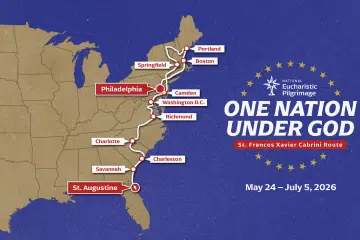Book examines roots of urban Catholic schools
Monday, July 26, 2010
By Mary Caffrey Knapke
DAYTON DEANERY — How has Catholic education evolved in some of the largest cities in the United States?
That’s the question examined in Urban Catholic Education: Tales of Twelve American Cities, co-edited by Thomas Hunt, a University of Dayton teacher education professor and fellow in UD’s Center for Catholic Education, and Timothy Walch, director of the Herbert Hoover Presidential Library. The volume, recently released by Alliance for Catholic Education Press at the University of Notre Dame, contains a dozen essays that describe the evolution of Catholic education from its earliest days in this country until the middle of the 20th century.
 |
| Thomas Hunt poses with his most recent book, Urban Catholic Education, as well as some of the other books he has authored or edited. (CT/Mary Caffrey Knapke) |
“The history of Catholic schools in the United States is a tremendous story, and I think that story needs to be told and appreciated,” said Hunt, who was inspired to compile the book after reading a 2008 report published by the Thomas B. Fordham Institute, “Who Will Save America’s Urban Catholic Schools?” The study found that 1,300 Catholic schools in the United States had closed since 1990. But the essays in Urban Catholic Education reveal that struggles in Catholic education are not unique to the present day.
“It was not clear until the 1820s that Catholicism in general, and Catholic schools in particular, would survive in this country,” the editors write in the book’s introduction.
Yet the diverse Catholic experience in this country is reflected in the history and success of Catholic education. “Just as past generations survived and even thrived, so will future generations of American Catholic schools thrive in the next century,” the editors write. “The common threads of our past keep our future in perspective.”
That connection between the past and the future is why it’s important to remember the challenges and successes of previous generations, Hunt said.
“History is like a river — a living, moving body of water. As it travels from one point to the next, it picks up earth and sediment all along the way. And all the experiences we have in our lives are like rivers, too — everything influences our history. There’s a legacy here. We’re connected with the past.”
Hunt attended Catholic schools while growing up in Wisconsin and noted that “many Catholics, lay as well as clergy, deserve credit for the survival and success of Catholic schools in the United States. The one group who, above all, merits our gratitude for the schools’ very existence and accomplishments are the thousands of vowed religious women — nuns — who taught in these schools.”
Among the Catholic schools studied from coast to coast, two common elements emerge. First, Catholic schools served to preserve the faith of Catholic children. Hunt said the schools “were safe havens for a religious minority that, rightly or wrongly, didn’t feel welcome in the public schools. It became a question of identity.”
In addition, the parochial school curriculum was revised throughout the generations to respond to various changes in the public schools and help prepare children for success in American society.
“The schools did not want parents to have to choose between the Catholic faith and making it in American society in the future for their children,” Hunt said.
Contributors include Roger A. Fortin, provost and academic vice president and professor of history at Xavier University.
Fortin’s essay describes Cincinnati’s immigrant roots; he writes that “the initiative taken by the immigrants, especially the Irish and Germans, is a testimonial to the significant influence that ordinary people exerted on the development of the diocese.”
In Cincinnati and in dioceses across the country, a changing social landscape in the 1950s and ‘60s extended to Catholic education as well.
“In the 1960s, the differences [between Catholics and non-Catholics] started to melt away. Protestants are no longer called heretics; they’re now separate brethren. Kennedy gets elected president. Catholics move to the suburbs. The history of ethnic Catholics in the cities becomes a thing of the past,” Hunt said.
In the future, Hunt and Walch may examine urban Catholic schools from Vatican II to the present day. First, however, they would like to do subsequent volumes about other cities, perhaps including Washington, D.C., Indianapolis, Miami or Denver. Until then, Urban Catholic Education provides insight into the storied history of Catholic education in 12 cities across the country. The book is available from Alliance for Catholic Education Press at acepress.nd.edu.
Mary Caffrey Knapke can be reached at [email protected].









